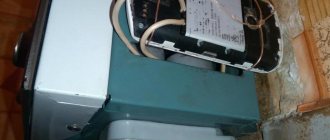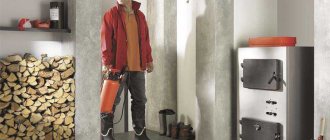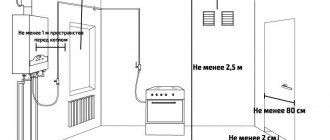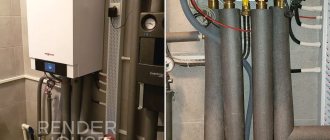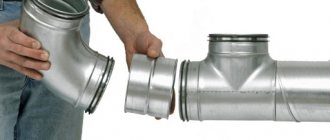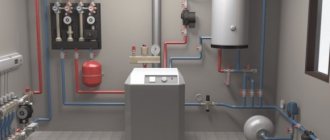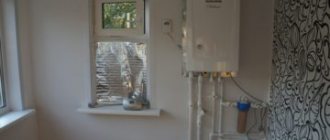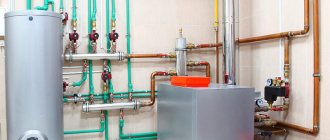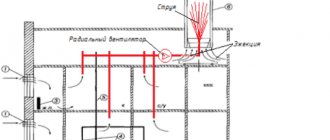Boiler
(English boiler - boiler) - a water heating device in the heat and hot water supply system [1].
As a rule, in Russian, “boiler” is assumed to be something different from a boiler, although there are other opinions [2]. According to the Rules for the Design and Safe Operation of Steam Boilers, a boiler
is a synonym for the word
water heater
: “a device heated by steam or hot water, used to heat water under pressure above atmospheric.”
Accordingly, a boiler-boiler
is a steam boiler in the drum of which there is a device for heating water used outside the boiler itself, or in the natural circulation of which a separate boiler is included during operation.
At thermal power plants, nuclear power plants and some boiler houses, boilers are network heaters in which the heating network water is heated by steam from turbine extractions or from steam boilers. The room where they stand is called the boiler room
[1] .
In everyday life, a boiler is often called any water heater: an indirect heating boiler (heating fluid obtained from a local boiler or heating network), an electric water heater and even a gas water heater.
Relatively recently, electric kettles with boiler mode and thermopots have appeared, in which a constant water temperature is maintained, sufficient for brewing tea or coffee.
Everyone has heard the word “boiler room” in one way or another; most people consider it ordinary and familiar. And this is the majority who answer the question - what is this? - answers: “Well, the boiler room is...” Indeed, not everyone can answer such a seemingly simple question right off the bat. Let's try to figure it out together.
What is a boiler room
Boiler installation - what is it and for what needs is it used? Logic dictates that the boiler room is the room where the boiler is located. It is a container for heating liquid.
Simply put, a boiler is a steel tank in which liquid for the domestic hot water system is heated in any way.
The point is not to deliver hot water from a thermal power plant to a residential area, but to raise its temperature right on the spot, thereby eliminating the inevitable heat losses during transportation.
Some houses do not have hot water supply at all, and the boiler system is the only source of hot water for them. In addition to the heaters themselves, other equipment is also needed - feed pumps, shut-off valves, control unit, measuring instruments, etc.
Boiler prices
Interesting Facts
- At the beginning of the film, while the New Line Cinema logo is shown in a square intersected by the film, portraits of US presidents are scrolled through, starting with the one on the dollar and ending with the image on the one hundred dollar bill. Although the hundred dollar bill features Benjamin Franklin, who was never president.
- During Seth's sales training, the phrase "Always close deals" is mentioned. from the feature film "The Americans".
- The film is based on the history of Stratton Oakmont and the life of Jordan Belfort.
Why do you need a boiler room?
A boiler room is needed to provide hot water to the residents of the house. The heating process can be carried out in various ways, which are selected depending on the availability of a heat source, or the greatest economic benefit from using the type of heating.
In an apartment building
In apartment buildings, the heat source is hot water (or steam) from the central heating system (CH). A boiler in an apartment building has the same purpose as in any other place, but from a design point of view it is somewhat different from other types, being an ordinary heat exchanger. The principle of its operation is simple: hot water from the central heating system (coolant) is passed through a container, inside of which there is a pipe system that does not communicate with the internal volume of this container. Cold liquid flows through them, which is heated by the coolant and sent to the domestic hot water system. That is, the coolant is used not only for heating rooms, it also provides the availability of hot water.
In a private house
In a private house that does not have a connection to the central heating system, the boiler performs the function of heating the liquid using heat from the boiler . Fuel can be electricity, gas, firewood, coal, briquettes, etc.
In this case, the term “boiler” is used according to tradition, but not entirely correctly. The exact name of such a device is a boiler, and the room for it, accordingly, is a boiler room. If there is a connection to the central heating system, then you can install a heat exchanger, but this possibility is still rare in rural areas.
Advantages and disadvantages of an autonomous boiler room
So, you are thinking about the possibility of installing your own boiler room, which would heat the entire apartment building and supply hot water to each of the apartments. What advantages and disadvantages should you know about in order to make the right decision that will not make you regret it in the future?
Diagram of a heating system in an apartment building
First, it’s worth talking about the shortcomings, since there are significantly fewer of them.
- The high initial cost of the project is the purchase of the equipment itself, its installation and the provision of communications to each of the apartments. Yes, initially each of the apartment owners in the building will have to invest a considerable amount so that the group of residents can make such an expensive purchase. Many owners may simply refuse to spend such a significant expense, even if it is a one-time one.
- The need to maintain the entire system in working position. If, when connecting to a heating plant, all responsibilities for servicing the equipment fall on the shoulders of the specialists of the company providing the services, now in case of any breakdown you will have to solve the problem on your own. This means that you will need to hire specialists who will regularly inspect the equipment and, if any breakdowns are identified, repair them. This can cause unnecessary trouble and financial costs.
This concludes the main disadvantages of an autonomous boiler room. Of course, they are very significant, which is why today not every home has a mini-boiler room installed. But still, the number of such mini boiler houses is growing rapidly. Why? Due to the following advantages of independent heating.
- Complete independence from city monopolists in housing and communal services. Everyone knows very well that in every city there is only one company that provides heating and hot water services to residential apartment buildings. And they can increase the cost of their services almost uncontrollably. If you install your own boiler room, then the monopolists will no longer have leverage over you.
- Reducing heat loss to a minimum. As practice shows, when passing through many kilometers of heating mains, the coolant (hot water) loses up to 30% of the heat received (depending on the distance from the city boiler house).
Example of heat loss in an apartment building
And end consumers also have to pay for this heat. In autonomous heating systems, heat loss is measured in fractions of a percent. So due to this, the payment is reduced by a third.
- A boiler room that heats one house, not thousands, is easy to set up. If the apartments become too hot, you can easily reduce fuel consumption, and on frosty days - increase it. Thanks to this, the temperature in the rooms will always be optimal, suiting each of the inhabitants. There is no need to ventilate the premises, lowering the temperature and at the same time releasing heat to the street, for which a lot of money was paid. But at the same time, you won’t have to use additional heat sources (electric heaters) to maintain a sufficiently high temperature in the apartment.
- In order for the boiler room of an apartment building to be kept in perfect order, it is enough to hire one dispatcher who monitors the readings of all devices, as well as one or two visiting technicians who are involved only when breakdowns are detected. If your house is connected to the city heating main, you will have to pay for the services of not only dozens (or even hundreds) of ordinary installers, but also hundreds of accountants, directors, their deputies, secretaries, drivers and many others. This also saves a lot of money.
- In most cases, heating of houses connected to the city heating plant begins on October 15 and ends by April 15. And even if autumn and spring turn out to be unusually cold or warm for a given area, no one will change the start and end dates of the heating season. Therefore, in the off-season, apartments are often too hot or too cold. The presence of an autonomous boiler room allows you to turn the heating on and off exactly when necessary. Most often, such decisions are made by the council of residents of the building. Of course, this allows you not only to reduce heating costs, but also to maintain optimal temperature in the rooms, regardless of the temperature outside the walls of the house.
What conclusion can be drawn from all of the above?
But it allows you to save a lot of money every month. Therefore, all initial costs will be compensated quite quickly, and very soon you will notice that you have free money that previously went to pay utility bills.
Boiler types
There are different heater designs made for different heat sources or fuel types.
The choice of type is determined by the availability of a certain type of energy or fuel. If there are several options, the most economical option is usually used.
The most common types of heaters are:
- Indirect. The transfer of thermal energy between different media is used.
- Flow-through. The pipe section heats up. Efficiency depends on the flow rate: the higher it is, the less efficient the heater is - the liquid does not have time to heat up to the required temperature. At the same time, you can use such a device immediately, without waiting for the required volume to heat up, and the hot water will never run out.
- Cumulative. Heating a liquid in a container of a certain volume. You can create any pressure - the temperature will not change. But when the tank is empty, you will have to wait for the new volume to heat up, which takes some time.
Soundtrack
- "New York (Ya Out There)" - Rakim
- "Keepin' the Faith" - De La Soul
- "Funky Child" - Lords of the Underground
- "Segue to Word" - The Angel
- "Sunset Eyes" - Ernie Andrews
- "You Don't" - Tricky
- "Right Here" - Pharoahe Monch
- "What a Thug About" - Beanie Sigel
- "Things Done Changed" - The Notorious BIG
- "Area" - De La Soul
- "Get on This" - Ugly Duckling
- "Ma Dukes" - O.C.
- "Award Tour" - A Tribe Called Quest
- "Supa Star" - Group Home
- "Anywayz" - Esthero
- "Destiny Complete" - The Angel f/ Mystic
- "Brand Nubian Rock the Set" - Brand Nubian
- "Impress the Kid" - Slick Rick
- "Simon Says" - Pharoahe Monch
- "Money or Love" - Saukrates
- "That Ain't Gangsta" - 50 Cent
Types of storage boilers
Storage heaters are divided into two types:
- Open (non-pressure).
- Closed (pressure).
A boiler device for heating open (non-pressure) water consists of a small container of approximately 5-10 liters, equipped with a special mixer that can shut off the water when the device is finished using. The heater does not create pressure and is suitable for use in garden areas for summer showers.
Closed (pressure) heaters can provide hot water to a country house. They have a large capacity - 50-200 liters, are built into the water supply system, and work on the principle of uniform mixing. That is, when hot water is taken, there is no sudden replacement of cold water, but new portions are gradually added, which contributes to a more even supply of hot water to the house.
Varieties
Today, the Russian domestic market offers a very large selection of electric water heaters of different types and types with different price ranges, while the build quality and individual parts can vary greatly. The electric instantaneous water heater has long enjoyed well-deserved popularity among users in different regions of the Russian Federation due to its simple operation. They are divided into two main types:
- pressure or closed type;
- non-pressure - open type.
The first option is capable of supplying hot water to several points at once: a washbasin, a shower stall, a kitchen, but for this it is necessary to ensure a fairly high pressure in the home water supply line.
The second option functions normally at any pressure in the main line with a connection directly to the water intake point.
Boiler room requirements
A boiler room in a private house must meet the requirements of fire safety, ease of operation, repair, and comply with the technical parameters of the equipment. In addition, it is necessary to accommodate a fairly large amount of equipment - the boiler itself, control and monitoring equipment, pumps, etc. All these devices must be installed in accordance with the technical requirements.
The size of the boiler room in a private house must be at least 6 m2, and the volume - at least 15 m3, with a ceiling height of 2.5 m. These requirements are established by the fire inspectorate and must be observed. In addition, such a room is most convenient for servicing or repairing equipment.
Is it possible to make a boiler room or boiler room in the basement of a private house?
The question often arises: “Is it possible to make a boiler room in the basement of a house?” To place a boiler room, the basement is the most convenient place, but there are limitations.
The fact is that in SNiPs such an arrangement is directly prohibited, but it must be taken into account that this means boilers running on liquefied hydrocarbon fuel (LPG), which was previously used to power equipment everywhere.
Today, the devices use natural gas, so the ban has been lifted. There are no restrictions for electric boilers.
Tips and tricks for installing equipment
In addition to specific requirements for installation and connection of equipment, there are general requirements for boiler rooms:
- The walls must be made of brick or concrete.
- Storage of flammable or explosive substances is prohibited.
- A technological gap is required between the equipment and the walls (determined from the equipment passport).
- The ventilation system is calculated based on the boiler power.
- The best finishing option is tiles, but you can use mineral plaster.
- Doors must open outward along the evacuation route.
The installation of a boiler room in a private house must fully comply with the needs of residents and the capabilities of network organizations. In the absence of central heating networks or gas mains, it is possible to create a completely autonomous heating and hot water system, independent of resource or electricity suppliers.
Video on the topic: installation of a boiler room in a private house
Comfortable living in a private house is impossible without such benefits of civilization as hot water and heating. But to get them, you need to put in a lot of effort. Especially if you plan to make your home completely autonomous - in this case, you cannot do without a special boiler room where heating and water storage devices will be located. Proper arrangement of this room is the key not only to properly functioning utility networks, but also to your safety, so we further suggest you figure out what requirements are put forward for the organization of a boiler room: dimensions, norms for equipment placement, connection diagrams - a theoretical assistant and a photo are for your attention.
Boiler room location
First, let's look at the definitions. A boiler room means a technical room with a whole range of special equipment, which is designed to organize hot water supply in the house. In parallel, the same complex is responsible for heating. That is why, taking into account its multifunctionality, it is more appropriate to call the room a boiler room, although both names are common in everyday life. There are three variations in the location of the boiler room.
- The first is inside the house: in the basement or basement, or in a remote room on the first floor.
- The second is in a special extension: the boiler room is built close to the house, mainly from the bathroom side.
Boiler room equipment
The uninterrupted operation of the boiler room, and, accordingly, the provision of hot water and heating to the house, is impossible without a whole set of special devices and communication elements. The mandatory components of the system include:
- The boiler is the main heat generator. It is here that the coolant is heated, which is subsequently supplied to the boiler and heating devices. Based on the source of heat energy, boilers are divided into five types: electric, gas, solid fuel, liquid fuel and combined.
- Boiler – water heater tank. Inside the container there is a tube through which the hot coolant moves - it transfers heat to the water in the boiler, thereby heating it to the required temperature.
- Distribution manifold - pump, hydraulic distributor and comb. This unit ensures the distribution and uninterrupted circulation of the coolant throughout all elements of the working system.
- Hydraulic accumulator - expansion tank: compensates for the increase in pressure during the heating of the working coolant.
- Safety devices - air vent, safety valves, pressure gauge: protect the system from excess air and excess pressure.
- Automation – various kinds of electronic devices that are designed for coordinated control of all components of the heating and water supply system.
- Chimney - outlet pipe: removes the combustion products of working fuel to the external environment. There is no urgent need for a chimney only if an electric boiler is used in the boiler room.
- A set of shut-off valves designed to quickly shut off the flow of coolant in case of emergency situations.
How to ensure water supply through pipes - connection diagram
First, let's look at the internal components of the boiler itself. It includes the following parts:
- coil: located inside the water heater and is required to heat the liquid using circulating coolant;
- thermostat: designed to control the temperature of the water inside the boiler itself; when the control temperature is reached, the device turns off automatically and starts working again when the water cools down;
- insulation: ensures long-term heat retention inside the water heater and does not allow the water to cool quickly;
- water supply pipes: they connect the device and the heating system, connecting to the coolant source.
When the boiler itself is already installed in its place, you can begin to connect it to the heating network. It is necessary to remember that the water heater has 4 pipes through which cold and hot water supply passes. They need to be connected according to this diagram.
During one circle with water, the following happens:
- cold water enters the device through 1 pipe;
- using a coil it heats up and remains in the boiler until the thermostat stops heating;
- Water flows through the pipes into the batteries and heat supply occurs.
Advantages
Such a system has its undeniable advantages. After all, the boiler in this case performs two functions at once, which makes it the most indispensable device in a house or apartment. The device has the following advantages:
- wastes significantly less heat than conventional heaters, this is due to a special layer of thermal insulation;
- simple and convenient installation that does not require much energy;
- saves a lot of money and does not require large installation and maintenance costs; heating boilers are much more expensive than average boilers. Old water heaters are the most economical to use;
- you can independently adjust the required temperature level or stop the heat supply altogether;
- easy to assemble yourself at home, no special tools or plumbing equipment, skills and knowledge in this area are required, just strictly follow the instructions;
- the heating itself comes from the coolant, which reduces the risks of breakthroughs and improper functioning of the system;
- You can use hot water and heating at any time, even if an accident occurs at the station; this is especially common among pipe breaks at thermal power plants in winter - the house will always be warm.
Basic requirements for a boiler room
All requirements for the arrangement of a boiler room can be divided into two categories: those relating to the room itself and the equipment. Let's start with the first ones.
The boiler room must have a large area - at least 6 sq.m. The minimum volume of the room is 15 cubic meters. The ceiling height should be 2.5 m or more. These requirements are determined not only by safety measures, but also by the ease of maintenance of the heating and hot water system - it is important to ensure free access to all pipes and appliances.
The walls of the boiler room are made only of fire-resistant materials - concrete or brick. The floor is made of concrete. For finishing cladding of both walls and floors, it is recommended to use relief tiles. An acceptable alternative for walls is non-combustible mineral plaster. If the boiler room is installed directly in the house or in an extension to it, it must be separated from neighboring residential premises by reflective walls made of material with a zero fire spread limit. The door of the boiler room must be fireproof. It is recommended that it opens outwards.
A ventilation system must be organized in the boiler room. If it is not possible to install special fans, you should take care of natural ventilation - make a 15x20 cm hole in the upper zone of the room.
equipment requirements
When installing equipment in a boiler room, you should remember the following rules:
- There should not be more than two heating boilers in the room.
- The minimum distance between large appliances (boilers and boilers) is 70 cm.
- Neither the heating boiler nor the boiler should be adjacent to the surface of the walls on either side - there must be free space between the appliances and the walls.
- If the boiler room is located on the ground floor of the house, the total power of the system equipment should not exceed 150-200 kW, and if in an extension, in a semi-basement or basement - 350 kW. In the case of boiler rooms in individual buildings, such strict standards are not provided.
- Electrical wiring must be covered. The best option is to hide it in special steel pipes.
- Lamps must be covered with metal mesh housings.
As you can see, the arrangement of a boiler room, or boiler room, in a private house requires compliance with many standards - starting from the dimensions of the technical room and ending with its equipment. Violation of these requirements is fraught with major troubles, so take into account all the nuances if you want to get a truly effective and safe heating and water supply system for your home.
Where you can and where you can’t place a gas heating boiler
The most common and suitable accommodation options are a kitchen or a separate room:
- on the first floor;
- on the ground floor;
- in the basement of the house;
- in the attic.
– Is it possible to install a gas boiler in the bathroom?
No, it's not possible. The opinion is becoming increasingly widespread that gas boilers with a closed combustion chamber do not take air from the room, and therefore can also be installed in the bathroom. Firstly, this still does not comply with SNiP standards, so the gas service is almost guaranteed to prohibit this location option. Secondly, even if the combustion chamber is isolated from the room, the high humidity characteristic of the bathroom will greatly reduce the service life of other metal elements of the boiler, especially electronics.
– Is it possible to install a gas boiler in the garage?
It is possible if the garage meets all the requirements for the size and volume of the room, glass area, has a foundation, official design and appropriate ventilation. Also in the garage itself you can organize a separate room for a furnace room.
– Is it possible to place a gas boiler in the studio?
The question most likely applies to apartments, but they often connect the kitchen and living room/hall in private houses. In any case, placing a gas boiler in a standard studio is prohibited, since the room with the boiler must be separated by a door. A glass door also counts as a door. And even any sliding structure.
– Is it permissible to install a gas boiler in a residential area?
No, placing a gas boiler in bedrooms, living rooms and other residential premises is prohibited.
– Are a fireplace and a gas boiler allowed in the same room?
There is no rule in any document prohibiting the installation of devices in the same room.
How to accurately calculate the required boiler powerIndividual calculation, formula and correction factors


